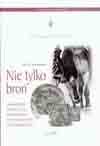Skóra w służbie wojny. Militarne i pozamilitarne, skórzane elementy wyposażenia wojownika w średniowieczu. Przegląd problematyki
The leather in service of war. Military and beyond military, leather elements of the warrior’s equipment in Middle Ages. Review of problems
Author(s): Arkadiusz Michalak, Piotr WolaninSubject(s): Archaeology
Published by: Łódzkie Towarzystwo Naukowe
Summary/Abstract: The variety of needs that warrior experienced during war with certainty determined the wealth of his equipment. Objects executed from animal skin were an important element of taken equipment. It seems, that the objects that were folded with the warrior in the grave, beside weapon, can be recognized as the essential element of his war activity. Mediaeval iconography as well as written sources also delivers information about other then military equipment used by warriors. The qualities of leather, good isolation, elasticity, lightness, relative easiness of forming, large accessibility, caused that from the earliest times the different elements of armament were executed from it. Integral parts of side-arms were produced from leather: early-mediaeval and medieval swords grip coverings, rain guards, sword sheaths, swords belts. Manufacturers of weapon also used leather elements: the strap which joint the head of war flail to wooden handle, was made of leather, fragment of leather was put to the axes to better servants to their storage. The armourers used leather as material on thatches of quivers, archers band on the wrist protecting the joint of palm from bowstring as well as to executing the catapult. The leather material was also used by them to produce protections of head and body (helmets, armours and shields). The leather material was also the basic material used to produce horse and riding equipment (spurs straps, leather strap for stirrup, whips, the elements of saddles, leather harness fittings). Girdles were an important element of mediaeval fashion, clipping different elements of clothes and also element to which bags and sheaths were added. Unfortunately, using our criteria, we cannot qualify the form of shoes preferred or especially designed to use in war. We can assume that “civil” footwear was used, and it depended on warriors’ individual preferences, was a result of fashion and also atmospheric conditions and field in which war working rolled. During war expeditions warriors had to possess gloves. The elements of top clothes were also executed from leather. With regard on isolating values of leather, it had to be used to its production unusually willingly. Among executed from leather objects, and taken to war, containers had to be also for liquids: bottles, leather bags and leather pails. The size of this article doesn’t let us discus the whole problems of using leather in needs of war. Introduced review of warrior’s inventory shows however large wealth of leather objects being in his equipment by whole Middle Ages. We hope, that more far complex studies, first of all, over mediaeval iconography, will let us know all the aspects of “men of war” leather equipment.
Journal: Acta Archaeologica Lodziensia
- Issue Year: 2008
- Issue No: 54
- Page Range: 99-120
- Page Count: 22
- Language: Polish

